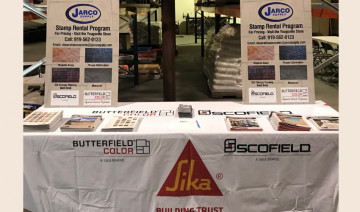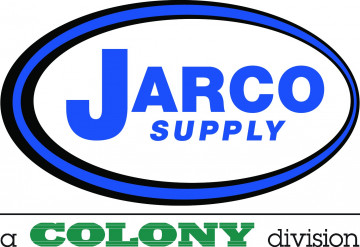
Troubleshooting CHROMIX®G Integrally Colored Concrete
Jarco Supply is proud to partner with Sika Decorative Concrete to bring the premier and most versatile decorative concrete products to the North Carolina and surrounding construction markets. Our branches are stocked with both Scofield and Butterfield products ranging from made-to-order integral color, concrete hardeners, antiquing release agents, stains, polishes, sealers, and decorative concrete tools. Come to Jarco Supply and learn why Scofield is the brand most specified by architects and engineers and Butterfield is the brand most preferred by contractors.
Recently, we provided two comprehensive blog posts dealing with decorative concrete. The first post detailed the proper way to batch concrete using CHROMIX® G admixtures. The second provided proper techniques for placing, finishing, and curing CHROMIX® G integrally colored concrete. If you missed these posts, please visit our website blog to catch up on the first two steps of the decorative concrete process.
Today’s blog discusses how to troubleshoot integrally colored concrete and provides some great tips and techniques for success! As in all things concrete, issues will come up and often those issues can be solved with the right knowledge, product, and partner!
As we remember from previous blogs, the goal of this process is to create #prettyconcrete and there is a RIGHT WAY to do it. Jarco Supply is your supplier of choice for the best decorative concrete products in the industry AND the expertise to help you become a premier decorative concrete contractor!

Decorative Concrete Common Problem #1 – Entrapped Moisture
Entrapped moisture in integral colored concrete can result from any of the following:
- Early and/or over finishing
- Sealing bleed water at surface (more prevalent with magnesium float)
- Over-wetting subgrade allowing for standing water
- Poor drainage
- High water table
- Adding extra water to loads (retempering)
- “Blessing the slab” – sprinkling the surface with water during finishing
- Uneven or no curing
- Using curing materials that entrap moisture such as polyethylene sheeting, curing blankets, and plywood
- Trowel burning
How to Remedy Entrapped Moisture
The following procedures are a recommendation to reduce or eliminate discoloration from entrapped moisture. Results will vary depending on technique, materials used and jobsite conditions. This is to be used as a guide only. No matter what type of treatment used, always follow the manufacturer’s suggested procedures to ensure the best results.
Removing dark discoloration
Dilute acidic solutions such as muriatic acid, acetic acid, phosphoric acid or products concrete cleaners, which are pre-manufactured blends of acidic solutions. When blending, muriatic acid can be diluted with
water at rates of one part to 20-30 parts of water depending on how severe the discoloration is, or if you are going to etch the surface of the concrete. For both acetic and phosphoric acids one part to 20 parts of water is a common dilution to use. Observe local and federal requirements for handling of acids.
Removing light discoloration
Non-acidic treatments should be tried first, typically using water and a neutral detergent. If this doesn’t work then the acidic type products stated above should be tried next.
Step #1 - SAFETY
Many of the treatments suggested, will involve the use of materials which are acidic in nature. Always use the manufacturer’s recommendation to provide the proper safety procedures when handling these materials.
Step #2 - PREPARATION - Surface and Air Temperatures
Before the application process can begin it is always recommended to let newly placed integral colored concrete dry and cure out before cleaning the surface. Depending on the time of year this may take several months to achieve. This will prevent any excessive moisture (whether internal or external)
from potentially causing unsatisfactory results due to staining or blotching of concrete. Never apply treatments when outside temperatures are freezing or will be freezing overnight.
Step #3 - PREPARATION - Equipment
When using acidic solution use a stiff-bristle non-metallic brush, a soft fiber masonry washing brush, or low-pressure spray (50 psi max.) equipment fitted with acid resistant hoses and gaskets. Do not exceed 50 psi as it may significantly etch the surface of the concrete and will make rinsing the solution difficult. Do not atomize. Pressure rinsing equipment that provides at least 400psi at 4-6 gpm delivered through a 15–40-degree fan spray tip often provides the best results. Always test to determine the optimal rinsing pressures and water volumes.
Step #4 - PREPARATION - Before Final Application
Always test each type of surface for suitability, dilution rates, and desired results before the overall application. Always let the surface dry before inspection of results. If using a prepared acidic solution from a manufacturer, always use their recommended dilution rates.
Step #5 - APPLICATION
Make sure the surface is free from all contaminants such as dirt, oil, and grease. This may require pressure washing, sand blasting or scrubbing with a rotary floor machine. This will depend on the surface finish and the condition of the concrete. Always pre-wet the surface with fresh water before applying acidic solution. Significant etching can occur if this method is not followed. Apply the material to the surface with a brush or low-pressure spray. Let the material remain on the surface for 3-5 minutes or until the discoloration is gone. This will vary depending on the dilution of the material used. Keep people away from cleaner once on surface. Rinse thoroughly with fresh water to get all the material off the surface. If pressure rinsing is not available, brush the surface while rinsing with clean water. Reapply the material as necessary to remove discoloration. Keep in mind that repeated applications might etch the integral colored concrete surfaces. Always clean up tools and equipment with fresh water after acidic treatments. The application of a sealer and or curing compound, such as LITHOCHROME® Colorwax™ or SCOFIELD® Cureseal™ can help maintain color vibrancy.
Decorative Concrete Common Problem #2 - Wet Broom Marks
Wet broom marks in integral colored concrete can result from any of the following:
- Adding excess water to end of broom for easier finishing. The excess water causes the light streaks on the surface of the concrete only.
- Adding surface water and then brooming it in
How To Remove Wet Broom Marks
Wet broom marks can be removed using the same procedure for removing entrapped moisture, as the light areas are due to surface water finished in by the broom. Once this treatment is applied, an application of a sealer and or curing compound, such as LITHOCHROME® Colorwax™ or SCOFIELD® Cureseal™ can be applied to maintain color vibrancy.
Decorative Concrete Common Problem #3 - Efflorescence
Efflorescence is a salt deposit that forms on the surface of the integrally colored concrete. Water migrates through the concrete, dissolving soluble compounds (calcium hydroxide), and then evaporates, leaving a white powdery substance (calcium carbonate) on the surface of the concrete. Efflorescence can result from the following:
- Adding excess water to the mix creating highly porous concrete
- Using pea gravel mixes that contain high amount of water
- Materials that contain high levels of salt (Water, aggregates, cement)
- Retempering with water on the job
- Having subgrade that has freestanding water
How To Remove Efflorescence
Efflorescence can be removed using the same procedure for removing trapped moisture. The use of acidic cleansers is preferred, especially if the efflorescence is severe. In minor cases the use of a mild detergent and scrubbing with a non-metallic brush may be all that is necessary to remove efflorescence. Keep in mind that etching of the surface may happen. Once this treatment is applied an application of a sealer and or curing compound, such as LITHOCHROME® Colorwax™ or SCOFIELD® Cureseal™ can be applied to maintain color vibrancy. The use of a mix with a low w/c .50 or lower, the use of fly ash, and proper curing and sealing can go a long way in reducing the possibility of efflorescence.
YOU’RE ON YOUR WAY TO DECORATIVE CONCRETE EXCELLENCE!
When you partner with Jarco Supply for your decorative concrete projects, you have made a conscious decision to achieve decorative concrete excellence. Our commitment to service doesn’t end at the sale. Our team is ready to help you determine which products are right for your next decorative concrete project and give you the tools and knowledge you need to do it successfully. We are also committed to helping you solve your decorative concrete issues that undoubtedly will arise. Visit or call your local Jarco Supply today!
